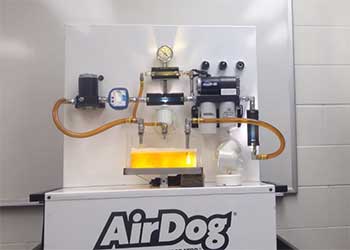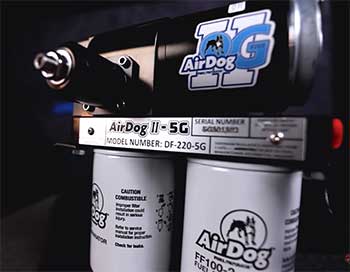Over the past decade, automated fuel delivery systems like the AirDog have become an increasingly popular option for diesel truck owners looking to improve engine performance and efficiency. The AirDog uses advanced filtration to remove water and particulates from fuel before delivery to the engine. This helps prevent issues like corrosion and injector fouling while stabilizing fuel consistency in all conditions.
The AirDog is available in two core product lines – the 4G series and the newer 5G models. But with different features across connectivity, intelligence, and hardware capabilities, deciding between 4G Vs. 5G AirDogs poses an interesting dilemma for most buyers. This comprehensive guide examines the key strengths and limitations of both model ranges to help determine the right fit.
AirDog 4G Vs. 5G Feature Comparison
| Features | AirDog 4G | AirDog 5G |
| Pricing | $$$ | $$$$ |
| Filtration Rating | 2 micron | 2 micron |
| Max Flow Rates | Varies by model – 100-250 GPH | Varies by model – 100-250 GPH |
| Water Sensor | ❌ | ✅ |
| App Enabled Controls | ❌ | ✅ |
| Warranty | 2 years | Limited Lifetime |
| Automatic Protective Modes | ❌ | Overheat, Overload, Water Sensor, etc |
| Cold Weather Performance | ✅ | ✅✅ |
| Durability Testing | 500 hour salt spray | 1000 hour salt spray |
| Electrical | Traditional relay | Sealed relay |
| Power Draw | 8-10A | 10-15A |
Overview Of Core Differences
While the 4G and 5G AirDogs share the same underlying precision fuel delivery fundamentals, the newer 5G line adds several intelligent capabilities:

- Connectivity – 5G models enable monitoring and control via smartphone apps, Alexa, and other smart devices. 4G lacks connected features.
- Sensing – 5G AirDogs have integrated water sensing to shut off automatically during contamination. The 4G does not sense water.
- Hardware – Durability and reliability improvements including sealed relay power, updated filter media tech, and flexible mounting options highlight the 5G units.
In essence, those needing connected truck tech and maximum protection from water damage may find the 5G AirDog worth the extra cost. But 4G models offer proven performance at greater value for most everyday needs.
Key Pros And Cons: AirDog 4G Series
Pros
- Significant gains in horsepower, torque, and efficiency from precision fuel supply
- Smoother running, more responsive engine across RPM range
- Vastly improved filtration removes over 98% of particulates and water
- Protects entire fuel system from degradation – including pumps and injectors
- Higher quality construction than competitors – built to last
- Easy 20 minute DIY install for any 12V diesel engine
- Works well even in extreme weather and altitude
- Available in range of sizes to match different fueling needs
Cons
- Lacks “smart” features like app controls or sensor integration
- Water sensor and automatic shutoff not available
- Shorter warranty period than 5G models
- Lower reliability at very high fuel flow rates – not ideal for some performance builds
- Cannot actively adjust based on real-time engine parameters
The 4G AirDog is best suited for basic fuel protection and performance gains across typical highway, work, and recreational applications. It delivers on core filtration reliability at a competitive price point.
Key Pros And Cons: AirDog 5G Series
Pros

- Integrates with telematics and other smart vehicle tech
- Protects engine automatically via integrated water sensor
- Dial in perfect fuel curve adjustments from smartphone
- Guaranteed compatibility with high flow rate performance builds
- Longer warranty coverage for peace of mind
- Excellent contaminant removal with selective filter media tech
- Handles extreme environments from cold starts to desert heat
- Higher reliability components including sealed relay power
- Flexible universal or direct fit mounting options
Cons
- Smart features and water sensing add bulk and complexity
- Much more expensive upfront cost
- Overkill ” bells and whistles” for basic fuel filtration needs
- App connectivity could pose future issues if abandoned
- Potential reliability questions on first-year 5G model
- No option currently for passive, non-powered operation
With cellular and WiFi connectivity, real time sensor integration, and design tweaks focused on rugged reliability, the 5G AirDog sets the benchmark for intelligent fuel conditioning. It justify the premium pricing for many owners needing to protect high performance engine builds. But casual users find the 4G provides sufficient filtration performance at far lower entry pricing.
Also watch the video!
Frequently Asked Questions (FAQ)
For basic fuel cleaning on typical diesel builds, the 4G AirDog provides tremendous value. But those wanting to monitor or automatically adjust fuel delivery in real time are better served by the 5G line despite higher costs.
The AirDog 2 succeeded the original AirDog back in 2010 with a redesign focused on quieter operation, flexibility for different installations, and greater range for fuel flow rates. The AirDog 2 remains on the market today as a cost-effective mechanical filtration option.
The numbers in AirDog models indicate the maximum fuel flow rate in gallons per hour (GPH). The AirDog 100 handles up to 100 GPH for stock and mild builds, while the 150 GPH systems supports race and high performance engines needing more fuel volume.
Both AirDog and FASS make high quality fuel delivery and filtration systems proven effective for diesel applications. AirDog tend to fare better in extreme weather and contaminants given attention on filter media tech and shutdown protection. But FASS offers remote mounting and potentially quieter operation at similar price points. Most customers find both brands satisfy diesel performance needs.
Also Read: DPF Vs. DEF – A Detailed Comparison Of Diesel Emission Systems
Conclusion
Adding an AirDog fuel pump, filter, and controller upgrade delivers transformative diesel engine protection and efficiency gains no matter which model selected. Their two-micron filtration brings commercial grade fuel cleansing down to an easy install for everyday truck owners.
For most drivers doing typical hauling, commuting or towing, the proven AirDog 4G hits the performance sweet spot without breaking the bank. But advanced users ready to monitor vitals or take protection against water damage to the next level find the 5G well worth the premium.
At the end of the day, both 4G and 5G AirDogs reflect American engineering and quality manufacturing that pays back over the long run – even if only through peace of mind in bad weather despite marketing hype. If you rely on a diesel engine to make a living, choosing AirDog means choosing performance.